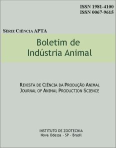Physiological studies of six cultivars of Panicum maximum Jacq
Abstract
This experiment was carried out at the Instituto de Zootecnia, Nova Odessa, State of São Paulo, Brazil, from August/1982 to July/1983, testing six cultivars of Panicum maximum with three fertilization levels. The utilized design was in a randomized blocks with a fatorial scheme of 6 x 3, with three replications, totalizing 54 plots. During twelve monthes, once a month, it was evaluated the height of apical meristem, to know the best management and the tiller€™s number of labeled canopies in order to know the efficiency of regrowth. It was concluded that the low management (15€” 20cm height) is apropriated for the cultivars Hamil, IZ-1, SEA-12 and Red Colonial and the high management (20€” 30 height) for: Wurth and IPEACS. The cultivars that had an increase in their number of tillers with increase of the fertilization€™s levels were: IPEACS, Wurth and SEA-12, all under medium and/or high fertilizations levels. Higher tillers were observed on cultivars Wurth and IZ-1 under medium fertilization and on Red Colonial under high fertilization levels.Downloads
Downloads
Published
Issue
Section
License
Os autores não serão remunerados pela publicação de trabalhos, pois devem abrir mão de seus direitos autorais em favor deste periódico. Por outro lado, os autores ficam autorizados a publicar seus artigos, simultaneamente, em repositórios da instituição de sua origem, desde que citada a fonte da publicação original seja Boletim de Indústria Animal. A revista se reserva o direito de efetuar, nos originais, alterações de ordem normativa, ortográfica e gramatical, com vistas a manter o padrão culto da língua e a credibilidade do veículo. Respeitará, no entanto, o estilo de escrever dos autores. Alterações, correções ou sugestões de ordem conceitual serão encaminhadas aos autores, quando necessário. Nesses casos, os artigos, depois de adequados, deverão ser submetidos a nova apreciação. As opiniões emitidas pelos autores dos artigos são de sua exclusiva responsabilidade. Todo o conteúdo deste periódico, exceto onde está identificado, está licenciado sob a Licença Creative Commons Attribution (CC-BY-NC). A condição BY implica que os licenciados podem copiar, distribuir, exibir e executar a obra e fazer trabalhos derivados com base em que só se dão o autor ou licenciante os créditos na forma especificada por estes. A cláusula NC significa que os licenciados podem copiar, distribuir, exibir e executar a obra e fazer trabalhos derivados com base apenas para fins não comerciais.













